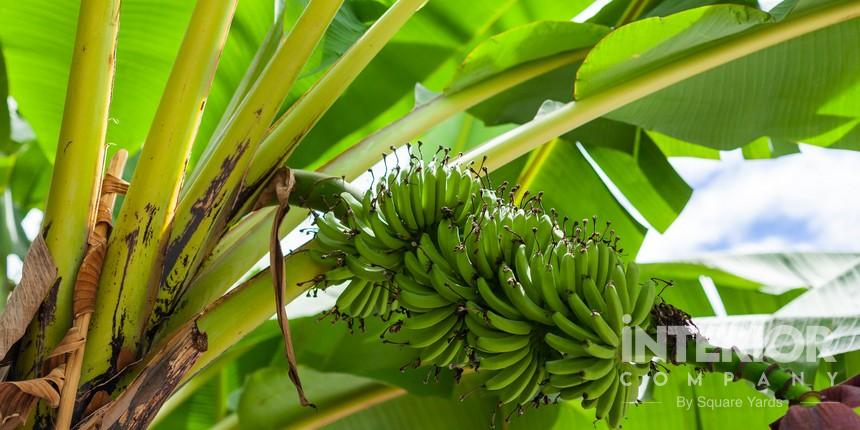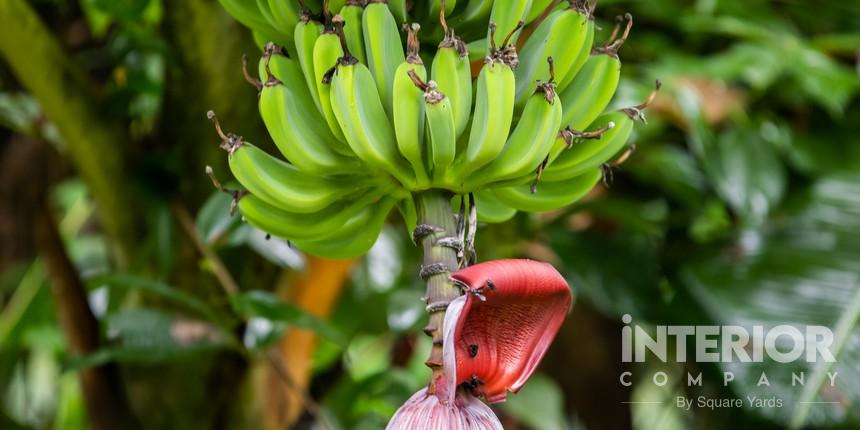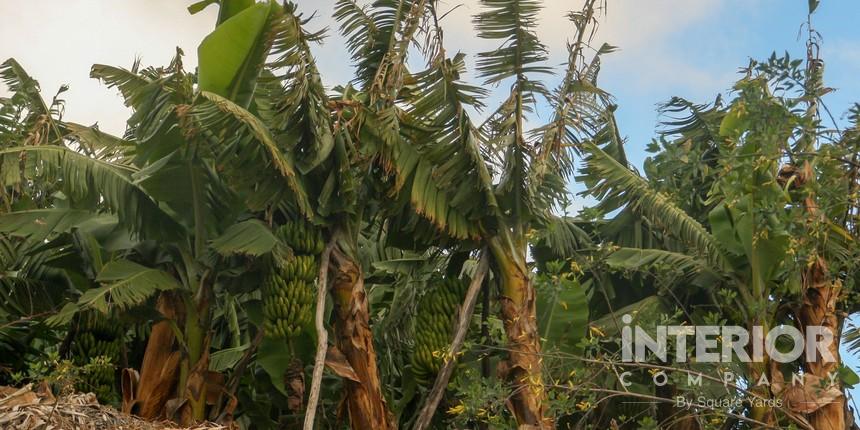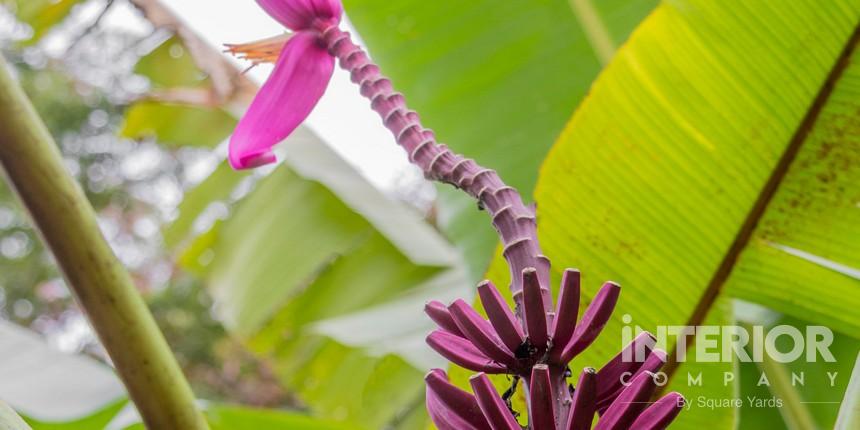Did you know that banana is not a tree?
Now, here we are to break the myth that the banana is a tree. You should know that a few refer to bananas as banana palm plants. The banana plant is a huge herbaceous perennial herb and called Zingiberales. You would be amazed to know that the stem of a banana is actually a false stem and hence known as pseudostem and the developing leaves stalk wrap up to form the pseudostem. The entire growth takes place in the pseudostem. The leaves start growing inside and join the stalk while the flowers grow and emerge on the top which further turns into a bunch of bananas.
Is it difficult to cultivate bananas?
To your amazement, these exotic banana plants have only a few basic requirements of growth, but consistent care is what they surely demand. You should take some time and learn everything about growing bananas. Here are a few things that should be provided to banana plants for rich growth:
- Regular moisture
- Regular warmth
- Nitrogen and Potassium
- Mulch and organic matter
- Regular humidity
- Rich and fertile soil
Apart from these requirements, one should know that banana plants do not like to grow alone, and its growth pattern is such that it develops in small groves. And these groves provide shelter to each other from the sun and wind. Thus, the available nutrients are all utilized when the plant grows in groves.
What is a Banana Tree Flower?
Banana Tree flowers are the blossoming of the plants and are surely edible. You can find multiple stalls selling banana flowers in the regions where its growth is prevalent which is in Asia. Banana flowers are nothing but underdeveloped bananas, if you let them grow, they will turn into ripe and fresh bananas. At times, these flowers are also referred to as banana hearts. The leaves can weigh up to a pound and are generally red or purple resembling the shape of a teardrop. The whitish-yellow florets need to be extracted, cleaned, and to remove the bitterness it is soaked in acidulated water. The internal leaves that are light pink are edible but require soaking too. You can add the florets to a bowl of water and add some vinegar or lemon juice to discard the bitterness that they possess. When you soak the flowers in water, they are prevented from browning which can happen to the internal parts while they are present in the air.
About the varieties of banana tree plant
Musa Basjoo

Musa Basjoo is famously known as the hardy banana or Japanese banana and is known to be a growth of the Sichuan region that is in China. Usually, the gardeners cannot believe that leaf of Musa basjoo droops after the first winter season, but it is so because this variety of bananas grows into a length of a small tree. But you should not worry about it and consider it as a herbaceous perennial which will die back in frost and develop new foliage back in the spring.
To sustain its growth, musa basjoo requires timely feeding and watering so that its leaves grow large and tropical in the warmth of spring. Also, musa basjoo compliments plants like persicarias, hedychiums, and scheffleras. This variety of bananas grows best incomplete sun or in partial light with the soil that is well-drained and incorporated with organic matter. In winters these hardy banana tree plants require some extra protection with their pseudostem covered with horticultural fleece and their roots with a layer of mulch. In areas where winters are mild, you might not require any extra protection for musa basjoo in the winters.
Musa Acuminata

It is a native of Southern Asia and majorly grown in the areas of Southeast Asia and the Indian Subcontinent. A lot from the range of edible bananas these days are from the species of Musa Acuminata and is one of the oldest cultivated domestic plants. To clear the myth musa acuminata is not a tree but an evergreen perennial and there is a sensing layer of leaf sheath that forms its pseudostem. This variety of bananas grows best in wet and tropical climates. During the daytime, these plants favour partial shade or filtered sunlight and the soil needs to be moist all the time. In their growing season, regular fertilization is required to get the best results.
Musa Balbisiana

This ornamental species of banana plant has flowers blooming in the shade range of red to maroon and fruits have a color palette of blue to green but are considered not fit to eat because of the banana seeds that they have. Also, it is known to be a plantain tree. Musa Babisiana can be commonly found in the areas of the Indian Subcontinent, southern China, Southeast Asia, and South Asia. One can assume that these bananas were cooked and consumed or else the variety of edible bananas would not have been cultivated. In Thailand and the Philippines, the leaves of this banana tree are used for crafts and packaging.
Musa Paradisiaca

It is a species of banana that is the crossover of Musa Acuminata and Musa Balbisiana. This one can be considered as a herbaceous perennial and suckering hybrid that grows fast in well-drained soil. The fruit produced is yellow-skinned and is considered fit for eating. Famously this plant is known to be the French plantain tree and its leaves can grow up to a height of 8 feet shaped like a paddle. In this species, the pseudostem dies down after it has produced the fruits. And, the flowers are yellow with bracts in the colour of purple to red.
All that you need to know about the growth and care of a banana plant
A long-time of nine months is required for a banana plant to fully develop, produce, leaves, flower, and fruits. When one cycle is completed the parent plant dies down and the fresh plant replaces it. You should be aware that in a non-tropical atmosphere a banana plant can’t develop fruits, but the leaves and flowering bananas are nothing but exotic. In case, it produces the fruit, it will not be an edible one.
Now the question is how to grow a banana plant?
Similar to the other rhizomes, the banana rhizomes should also be divided to prevent the harms of overcrowding. It is advised to separate them every year but if that sounds tedious, you should at least do it every three years. Division of banana rhizome is the best way to propagate bananas. To do this, you need to remove the pups from the rhizome but remember to use a sharp knife, and when you are through the cut ensure that the pup has multiple roots so that it’s easier to replant.
Through winter, you can plant the banana pups into small pots indoor and as the winter gets over, you can replant them in bigger pots or directly in the ground soil. The freshly planted young plants are delicate when placed outdoors after the first frost. You will have to take some measures to make your young banana plant get used to the outer atmosphere and do not expose them to direct sunlight for a few days after you have replanted them.
The successful growth of the banana tree plant
- To keep your banana plant from drooping, plant them after the harshness of the winters is set down. Do not expose them to a temperature which is above 57 degrees Fahrenheit because this will result in slower growth of the plant.
- Usually, the varieties of bananas prefer a good sun but some varieties which have high leaves should be kept in partial shade.
- To accommodate a banana plant, dig in-depth in the soil to provide them room for growth. For better results, you need to keep the soil ready for plantation. The soil should be mildly acidic, rich in organic matter, and well-drained.
- Banana Plants are needy of nourishment and require a lot of organic matter, green, sand, liquid fertilizers. The potassium levels need to be checked consistently. Since bananas comprise of potassium, it becomes a required nutrient for the overall development of the plant.
- Do not forget that banana plants come from rain forests hence, they require a good amount of moisture and water. And this is why they are planted in groups and not as a stand-alone plant because being nearby helps them to keep the moisture. Remember to water the plant every week and check for the moisture of the soil.
- To protect your plants from harsh winds, keep them in a spot that has some shelter. Their leaves tend to shred in strong winds but if the wind is quite harsh, it might break the stem of the banana which will die down your plant.
- Though the plant won’t die completely by its pseudostem getting broken, you will have to repeat the process of planting and taking care while hampering the fruit growth for that specific year.
- In extremely cold temperatures, the plant growth remains stunted. You can bring the plant indoors to avoid the harm of harsh winters.
Points for growing banana plants in pots
Would you believe that those huge banana plants are possible to cultivate in a container inside your home? Yes, if you get the growing conditions right, you can easily have a banana plant thriving indoors and in one year, you will have your banana plant producing fruits. Here are some points that you should consider while growing your banana plant indoor.
- Get a dwarf species of the banana plant because the usual ones can grow up to a height of 15 meters which will again be too huge to fit in a pot. Having a dwarf variety of banana plants will help in this condition because they will grow between 1.5 meters to 4 meters.
- You can purchase the banana tree or corm at a store or online. A corm is the part of the banana plant that contains roots. If you are not willing to wait for the corm to develop into a full plant, you can also go for a baby banana plant. This will skip the process of sucker development from the corm and the plant growth will be easier. You can also check out your local nursery to find a young banana plant.
- The soil for this plantation should be slightly acidic and well-drained. When you plan to get the soil for the banana plant, make sure that it has a proper mix of vermiculite, peat, and perlite. For banana plants, a soil mix that is ideal for cactus is the best fit. Avoid heavy potting soil for planting your banana tree plant and a ph level of 5.6-6.5 is ideal.
- Go for a container that is deep and has well drainage. Avoid using a pot that does not have a good drainage system. A deep pot is required for the growth of banana plants because it helps in the propagation of banana roots. And it all depends on your budget that you want a plastic, ceramic, or wood pot. In case your plant grows to be bigger than the capacity of your plant, transfer it to a bigger pot.
Some intriguing types of banana plants
Red Banana Tree

This variety of bananas is considered to be ornamental and has a skin color that is between the shade range red to purple, heavy foliage, and stems of scarlet color. Though the fruits produced are not edible, these give any house or landscape a good addition to beautiful flowering banana plants. Usually, the height of these banana plants is 6 to 10 feet and the fruits develop only on the mature plants.
Dwarf Cavendish Banana

The Dwarf Cavendish Banana plant is known to survive in almost every hardiness zone, and it gets its name because of the height of its stalk which is 8 to 10 feet. When the plant is young, the foliage is either red or purple but as the plant grows, the leaves turn green. The fruit that is [produced from the flower is of the standard size of 6 to 10 inches.
What is the use of banana trees?
- The banana tree produces edible fruits.
- One can also eat the banana skin of the edible varieties of banana
- In some varieties, the stem is also edible
- For some natural crafting materials, the fibers of the banana stem are ideal
- Certain garments can also be produced using banana fibers
- The foliage of bananas is extensively used as natural platters
- To pack your lunch, steamed banana foliage can be used
- Some varieties of banana produce edible florets
- The rhizome of the banana plant is filled with medicinal values